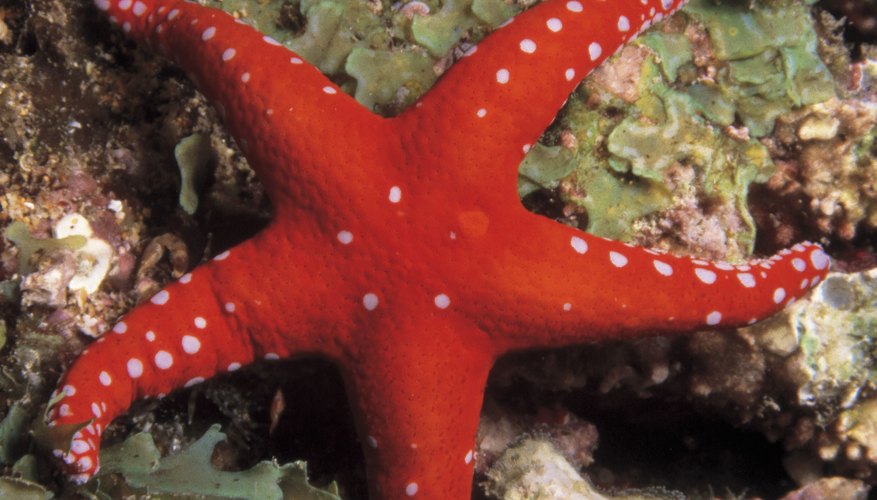Starfish are equally at home in the deep ocean and in rock pools on the beach. They are more accurately called sea stars, as they are not fish but echinoderms. There are about 2,000 species, and the variety in their habitats, diet and appearance indicates how well, as a genus, they adapt to their environment.
Appearance
Most starfish have five arms attached to a central disc, but some varieties have up to forty. Their bony shell acts as armour, and some species have developed spines for extra protection. Colours range from mottled brown to vivid scarlet or blue, depending on whether they need to hide in the sand from predators like sharks, or scare off smaller fish, or lurk among sea anemones. Because they live on the sea bed, and feed on creatures found there, their mouth is on the underside, while the upper surface filters water into the body.
- Most starfish have five arms attached to a central disc, but some varieties have up to forty.
- Their bony shell acts as armour, and some species have developed spines for extra protection.
Limbs
Sea stars have evolved suction pads on the underside of their limbs to enable them to move, catch their prey, and pump water through their body. Most proceed in a slow, rippling motion, but some burrowing species have special, pointed tubefeet adapted to digging into sand, so they can rapidly escape from danger. The suckers are so strong that they can cling to and prise open molluscs such as clams to get at the flesh inside.
- Sea stars have evolved suction pads on the underside of their limbs to enable them to move, catch their prey, and pump water through their body.
- Most proceed in a slow, rippling motion, but some burrowing species have special, pointed tubefeet adapted to digging into sand, so they can rapidly escape from danger.
If a sea star loses a limb to a predator, it grows another. In some cases, such as Linkia, a whole new sea star can regenerate from a severed arm. This is because sea stars have no central brain, but vital organs and a nerve network in each limb.
Feeding
Sea stars are carnivorous, but adapt their diet to whatever they find in their environment, including molluscs, worms and dead fish. To tackle large prey, they seize and hold it by suction, then push their stomach outside their body to envelop and digest the victim where it lies. This technique helps the genus survive as it makes a wider range of food available. Certain varieties, such as the Short-spined Pinaster, have specialised tubefeet that pull out the flesh of the prey.
- Sea stars are carnivorous, but adapt their diet to whatever they find in their environment, including molluscs, worms and dead fish.
Habitat
Sea stars have to live in a marine environment, because they depend on salt water to maintain their internal chemical balance. Water serves instead of blood to carry nutrients around the body, and is pumped in and out by the suction effect of the tubefeet.
Nevertheless, a few species have adapted to live in the brackish water around estuaries, where fresh river water mingles with salt sea water. Different species are found in different areas of the oceans, both in the shallow waters near the shoreline and on the deep seabed. Some inhabit underwater forests of kelp; others colonise and consume coral reefs.
- Sea stars have to live in a marine environment, because they depend on salt water to maintain their internal chemical balance.
- Nevertheless, a few species have adapted to live in the brackish water around estuaries, where fresh river water mingles with salt sea water.
